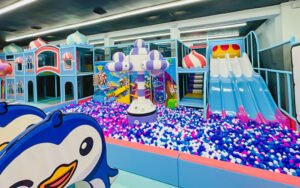Indoor playgrounds are more than just a rainy-day escape—they’re a booming niche in the U.S. family entertainment sector. In 2024, parents are increasingly seeking safe, engaging spaces where children can play, learn, and interact, regardless of the weather. This guide walks you through the process of starting an indoor playground business in the United States—from idea to first paying customer—while giving you real-world tips and avoiding costly beginner mistakes.

1. What Is an Indoor Playground Business?
An indoor playground is a climate-controlled, purpose-built facility designed for children’s play, often featuring slides, climbing structures, ball pits, soft play areas, and themed activity zones. Some also integrate cafes, party rooms, or educational play corners. Unlike outdoor parks, indoor playgrounds can operate year-round, making them an attractive venture in markets with seasonal weather or extreme climates.
2. Why It Matters in the U.S. Market
- Year-round demand: Parents need safe play options in winter, summer heat, and rainy seasons.
- Growing children’s entertainment market: The U.S. family entertainment sector is projected to grow to $XX billion by 2027 [SOURCE].
- Community hubs: Indoor playgrounds often become go-to spots for parent groups, schools, and birthday celebrations.
A fictional example: Last year, a small indoor play center in Denver reported steady weekday traffic from local moms’ groups, even before running paid ads. This illustrates the power of community integration.
3. Step-by-Step Guide to Starting Your Indoor Playground
Step 1 – Market Research
Interview parents, visit competitors, and study demographics. Look for gaps: underserved age groups, lack of toddler zones, or poor cafe options.
Step 2 – Define Your Concept
Decide if your playground will be adventure-themed, educational, or franchise-based. Include unique selling points (USPs).
Step 3 – Choose the Right Location
Opt for visible, accessible spaces with parking. Malls, strip centers, or converted warehouses are common choices.
Step 4 – Build a Business Plan
Outline your vision, market, operations, financial projections, and marketing strategy. Include contingency funds.
Step 5 – Secure Funding
Common options: SBA loans, investor partnerships, or personal capital.
Step 6 – Design and Equipment
Work with a certified playground equipment supplier. Ensure layouts comply with ASTM or CPSC standards.
Step 7 – Obtain Permits & Insurance
Requirements vary by state. At minimum, expect business licenses, fire safety inspection, and liability insurance.
Step 8 – Hire & Train Staff
Look for staff with childcare experience and customer service skills.
Step 9 – Marketing Pre-Launch
Tease the opening on social media, host preview events, partner with local influencers.
Step 10 – Grand Opening & Beyond
Offer opening discounts, run membership promotions, and collect feedback immediately.

4. Costs and Budget Considerations
- Rent: $2,000–$10,000/month depending on city.
- Equipment: $50,000–$150,000+ depending on size and complexity.
- Renovations: $20,000–$80,000.
- Staffing: $25,000–$50,000/year per full-time employee.
- Marketing: $5,000–$15,000 pre-launch.
5. Safety, Compliance, and Standards
In the U.S., follow ASTM F1918 and CPSC guidelines. Key areas:
- Soft surfacing under all play equipment
- Age-appropriate zones
- Regular cleaning schedules
- Emergency exits and signage
6. Operations, Maintenance, and Improvement Tips
- Daily: Inspect play areas, clean high-touch surfaces.
- Monthly: Rotate toys, review incident logs.
- Quarterly: Host themed events to attract repeat visits.
7. Marketing and Customer Acquisition
- Partner with schools and daycare centers.
- Offer birthday party packages with themed decor.
- Use social media reels showcasing happy customers (with permission).
- Run referral programs for parents’ groups.
8. FAQs
Q: How long does it take to open?
A: Typically 6–12 months from planning to launch.
Q: What age groups can I serve?
A: Commonly 1–10 years, with separate toddler zones.

9. Conclusion & Next Steps
Starting an indoor playground business in the U.S. is a rewarding venture—if done right. By combining thorough research, safety compliance, and creative marketing, you can build a space that families love and return to again and again.


